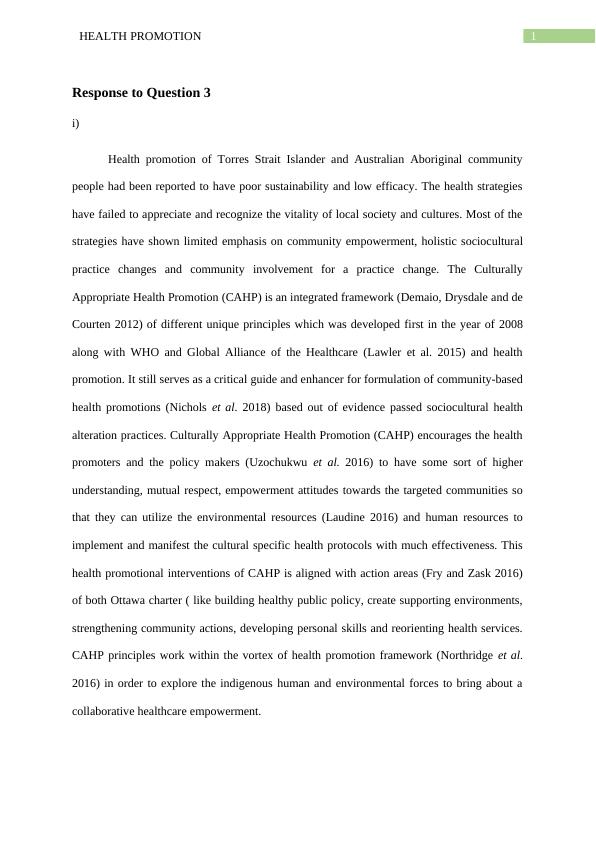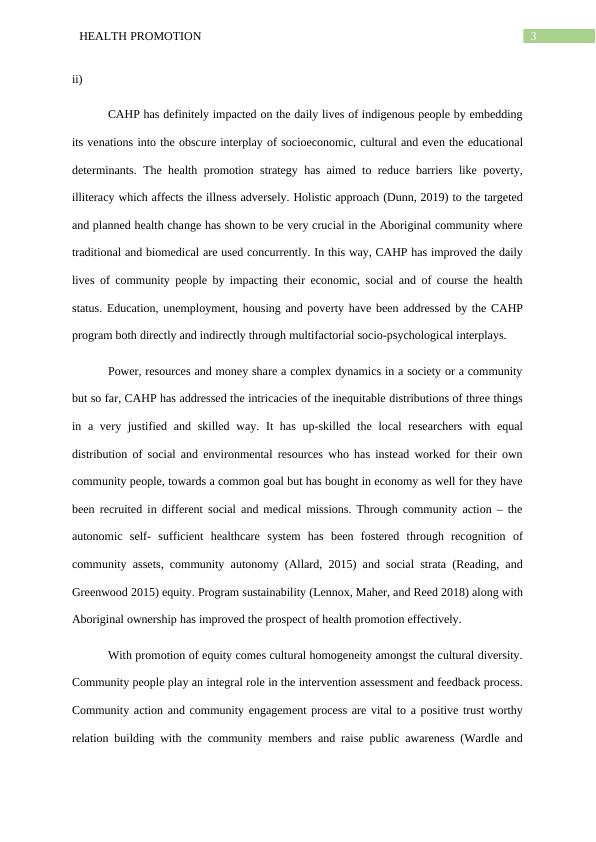Health Promotion in Aboriginal and Torres Strait Islander Communities
Added on 2023-03-30
12 Pages2915 Words482 Views
RUNNING HEAD: HEALTH PROMOTION
HEALTH PROMOTION
Name of Student
Name of University
Author note
HEALTH PROMOTION
Name of Student
Name of University
Author note

1HEALTH PROMOTION
Response to Question 3
i)
Health promotion of Torres Strait Islander and Australian Aboriginal community
people had been reported to have poor sustainability and low efficacy. The health strategies
have failed to appreciate and recognize the vitality of local society and cultures. Most of the
strategies have shown limited emphasis on community empowerment, holistic sociocultural
practice changes and community involvement for a practice change. The Culturally
Appropriate Health Promotion (CAHP) is an integrated framework (Demaio, Drysdale and de
Courten 2012) of different unique principles which was developed first in the year of 2008
along with WHO and Global Alliance of the Healthcare (Lawler et al. 2015) and health
promotion. It still serves as a critical guide and enhancer for formulation of community-based
health promotions (Nichols et al. 2018) based out of evidence passed sociocultural health
alteration practices. Culturally Appropriate Health Promotion (CAHP) encourages the health
promoters and the policy makers (Uzochukwu et al. 2016) to have some sort of higher
understanding, mutual respect, empowerment attitudes towards the targeted communities so
that they can utilize the environmental resources (Laudine 2016) and human resources to
implement and manifest the cultural specific health protocols with much effectiveness. This
health promotional interventions of CAHP is aligned with action areas (Fry and Zask 2016)
of both Ottawa charter ( like building healthy public policy, create supporting environments,
strengthening community actions, developing personal skills and reorienting health services.
CAHP principles work within the vortex of health promotion framework (Northridge et al.
2016) in order to explore the indigenous human and environmental forces to bring about a
collaborative healthcare empowerment.
Response to Question 3
i)
Health promotion of Torres Strait Islander and Australian Aboriginal community
people had been reported to have poor sustainability and low efficacy. The health strategies
have failed to appreciate and recognize the vitality of local society and cultures. Most of the
strategies have shown limited emphasis on community empowerment, holistic sociocultural
practice changes and community involvement for a practice change. The Culturally
Appropriate Health Promotion (CAHP) is an integrated framework (Demaio, Drysdale and de
Courten 2012) of different unique principles which was developed first in the year of 2008
along with WHO and Global Alliance of the Healthcare (Lawler et al. 2015) and health
promotion. It still serves as a critical guide and enhancer for formulation of community-based
health promotions (Nichols et al. 2018) based out of evidence passed sociocultural health
alteration practices. Culturally Appropriate Health Promotion (CAHP) encourages the health
promoters and the policy makers (Uzochukwu et al. 2016) to have some sort of higher
understanding, mutual respect, empowerment attitudes towards the targeted communities so
that they can utilize the environmental resources (Laudine 2016) and human resources to
implement and manifest the cultural specific health protocols with much effectiveness. This
health promotional interventions of CAHP is aligned with action areas (Fry and Zask 2016)
of both Ottawa charter ( like building healthy public policy, create supporting environments,
strengthening community actions, developing personal skills and reorienting health services.
CAHP principles work within the vortex of health promotion framework (Northridge et al.
2016) in order to explore the indigenous human and environmental forces to bring about a
collaborative healthcare empowerment.

2HEALTH PROMOTION
Strengthening public policies (Browne et al. 2017) for the Aboriginal and Islander
communities has delivered limited but useful responses amongst the community people who
have become more aware about their health with introduction of these policies. The locals
have taken up ownerships and been more oriented to the healthcare services. The diversity of
cultural beliefs (Pert et al. 2015) which are strongly related to their environments has been
targeted as well as an important strategy of this CAHP intervention. Culture and people share
a cause and effect relationship that this health intervention incorporates social determinants
(Marmot 2018), community action (Freeman et al. 2016), holistic and spiritual health
practices (Barker, Lamb and Campbell 2016) as accelerators of fast shifting community
healthcare transformation. The cultural determinants (Kingsley et al. 2018) like history,
dynamics, values, personal beliefs and ethics are also addressed by the principles of CAHP in
order to foster an effective health awareness and disease prevention. Personal skills of the
Aboriginal people and Islander people are targeted and stimulated as a cardinal intervention
of this community health promotion strategy. It is important to develop a self-sustainable
system. The CAHP interventions are community based and has set its values on the
priorities of the community. The health officers, the clinicians, social workers and nurses
working towards a community growth has lot to learn from the community people still to
make the intervention a success. A methodological development is promoted. Traditional
healers who had been an integral part of Aboriginal and Torres Strait islander community for
centuries are empowered as well to share their knowledge and skills in collaboration with a
modern biomedical approach (Bober, Beisel, and Nair, 2018)
Community involvement, empowerment (Ellis, E.M and Kral 2016) and consultation
is the first and foremost principle of CAHP strategy that uses the sociocultural framework to
achieve effective and respectful Aboriginal health enhancement. It partners with the local
people and mystic healers to forge a persistent public empowerment and health improvement.
Strengthening public policies (Browne et al. 2017) for the Aboriginal and Islander
communities has delivered limited but useful responses amongst the community people who
have become more aware about their health with introduction of these policies. The locals
have taken up ownerships and been more oriented to the healthcare services. The diversity of
cultural beliefs (Pert et al. 2015) which are strongly related to their environments has been
targeted as well as an important strategy of this CAHP intervention. Culture and people share
a cause and effect relationship that this health intervention incorporates social determinants
(Marmot 2018), community action (Freeman et al. 2016), holistic and spiritual health
practices (Barker, Lamb and Campbell 2016) as accelerators of fast shifting community
healthcare transformation. The cultural determinants (Kingsley et al. 2018) like history,
dynamics, values, personal beliefs and ethics are also addressed by the principles of CAHP in
order to foster an effective health awareness and disease prevention. Personal skills of the
Aboriginal people and Islander people are targeted and stimulated as a cardinal intervention
of this community health promotion strategy. It is important to develop a self-sustainable
system. The CAHP interventions are community based and has set its values on the
priorities of the community. The health officers, the clinicians, social workers and nurses
working towards a community growth has lot to learn from the community people still to
make the intervention a success. A methodological development is promoted. Traditional
healers who had been an integral part of Aboriginal and Torres Strait islander community for
centuries are empowered as well to share their knowledge and skills in collaboration with a
modern biomedical approach (Bober, Beisel, and Nair, 2018)
Community involvement, empowerment (Ellis, E.M and Kral 2016) and consultation
is the first and foremost principle of CAHP strategy that uses the sociocultural framework to
achieve effective and respectful Aboriginal health enhancement. It partners with the local
people and mystic healers to forge a persistent public empowerment and health improvement.

3HEALTH PROMOTION
ii)
CAHP has definitely impacted on the daily lives of indigenous people by embedding
its venations into the obscure interplay of socioeconomic, cultural and even the educational
determinants. The health promotion strategy has aimed to reduce barriers like poverty,
illiteracy which affects the illness adversely. Holistic approach (Dunn, 2019) to the targeted
and planned health change has shown to be very crucial in the Aboriginal community where
traditional and biomedical are used concurrently. In this way, CAHP has improved the daily
lives of community people by impacting their economic, social and of course the health
status. Education, unemployment, housing and poverty have been addressed by the CAHP
program both directly and indirectly through multifactorial socio-psychological interplays.
Power, resources and money share a complex dynamics in a society or a community
but so far, CAHP has addressed the intricacies of the inequitable distributions of three things
in a very justified and skilled way. It has up-skilled the local researchers with equal
distribution of social and environmental resources who has instead worked for their own
community people, towards a common goal but has bought in economy as well for they have
been recruited in different social and medical missions. Through community action – the
autonomic self- sufficient healthcare system has been fostered through recognition of
community assets, community autonomy (Allard, 2015) and social strata (Reading, and
Greenwood 2015) equity. Program sustainability (Lennox, Maher, and Reed 2018) along with
Aboriginal ownership has improved the prospect of health promotion effectively.
With promotion of equity comes cultural homogeneity amongst the cultural diversity.
Community people play an integral role in the intervention assessment and feedback process.
Community action and community engagement process are vital to a positive trust worthy
relation building with the community members and raise public awareness (Wardle and
ii)
CAHP has definitely impacted on the daily lives of indigenous people by embedding
its venations into the obscure interplay of socioeconomic, cultural and even the educational
determinants. The health promotion strategy has aimed to reduce barriers like poverty,
illiteracy which affects the illness adversely. Holistic approach (Dunn, 2019) to the targeted
and planned health change has shown to be very crucial in the Aboriginal community where
traditional and biomedical are used concurrently. In this way, CAHP has improved the daily
lives of community people by impacting their economic, social and of course the health
status. Education, unemployment, housing and poverty have been addressed by the CAHP
program both directly and indirectly through multifactorial socio-psychological interplays.
Power, resources and money share a complex dynamics in a society or a community
but so far, CAHP has addressed the intricacies of the inequitable distributions of three things
in a very justified and skilled way. It has up-skilled the local researchers with equal
distribution of social and environmental resources who has instead worked for their own
community people, towards a common goal but has bought in economy as well for they have
been recruited in different social and medical missions. Through community action – the
autonomic self- sufficient healthcare system has been fostered through recognition of
community assets, community autonomy (Allard, 2015) and social strata (Reading, and
Greenwood 2015) equity. Program sustainability (Lennox, Maher, and Reed 2018) along with
Aboriginal ownership has improved the prospect of health promotion effectively.
With promotion of equity comes cultural homogeneity amongst the cultural diversity.
Community people play an integral role in the intervention assessment and feedback process.
Community action and community engagement process are vital to a positive trust worthy
relation building with the community members and raise public awareness (Wardle and

End of preview
Want to access all the pages? Upload your documents or become a member.
Related Documents
Nurse Assignment Australia 2022lg...
|8
|2195
|20
Holistic Approachlg...
|4
|697
|85
Healthcare Management Assignment 2022lg...
|17
|4119
|8
Cultural Safety and Healthcare for Aboriginal and Torres Strait Islander Communities in Australialg...
|4
|585
|96
Promote Aboriginal Cultural Safety Assignmentlg...
|30
|7212
|347
Assignment on Ottawa Charter of Health Promotion Strategylg...
|9
|2223
|15
